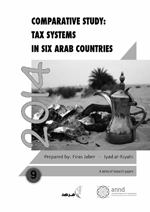Comparative Study: Tax Systems in Six Arab Countries
Published on Fri, 2014-11-21 12:35
The Arab NGO Network for Development (ANND), in collaboration with Christian Aid and Social and Economics Policy Monitor Palestine, explore in their comparative study on “Tax Systems in Six Arab Countries” how the tax systems of Arab countries have contributed to the lack of opportunity, growing inequalities, marginalization and exclusion suffered by the majority of people living in the Arab region. The revolutions witnessed by some countries in the region and the instability and crises in others are in part a demonstration of the people’s rejection of these inherent structural disparities. Paradoxically, as the report shows, it is the tax policies of these countries that present one of the key means by which local resources could be redistributed and mobilized to restore socio-economic justice to the poor and to foster more self-reliant development. Comparative Study: Tax Systems in Six Arab Countries See the publications here. The people of the Arab region have suffered from a lack of equal opportunity and inherent inequality as well as from marginalization and exclusion stemming from social and geographic causes, resulting in a system of rule and administration established through the reproduction of socio-economic injustice. The revolutions witnessed by some countries in the region, and the instability and crisis in others are in part a demonstration of the people’s rejection of the momentous socio-economic disparities resulting from unjust socio-economic policies imposed by regimes for decades. The situation was intensified by the implementation of deregulation and sweeping privatization deals, often in compliance with the recommendations of international financial institutions to the region’s governments. While these policies may have contributed to positive economic growth rates in countries like Egypt, Tunisia and Morocco, they did not produce positive results overall. In fact, they drowned Arab countries with debt and stripped them of their productive capacities and added-value production. For the majority of Arab people the promised growth did not materialize. On the contrary, disparities increased dramatically and growth has only benefited the elite. This has led to the widening in the gap between the rich and the poor in the region. In fact, the growing social disparity, inequality, marginalization, and exclusion in the Arab region left a scar on several areas of development, including health and education, added to cases of abject poverty and unemployment. While statistics show the improvement of indicators and access in regards to health and education services, the declining quality of these services must be addressed. This created islands of poverty and unemployment in the center and the peripheries, in the midst of deepening social protection difficulties. It also established a distorted legal environment that favors some businessmen and investors, without a clear strategy regarding the role of the private sector and foreign capital. Some demands put forth by the revolutions – sustenance, work, and education – under the slogan of social justice were a clear reflection of the social and economic crisis in Arab countries. A common characteristic is the absence of social protection and insurance systems, which are only available on a small scale and even where they do exist, they do not cover the requirements of decent living. Development in the Arab region is geared towards the elite, and not to the wider population. In most situations, this leads to increasing the gap between rich and the poor. The drawbacks of external financing and debt require an effective mobilization of local resources, in addition to strengthening the capacities of local production to be able to employ and produce, creating added-value. Tax policies are considered one of the most important issues in the redistribution and mobilization of local resources and could correct some of the economic imbalances arising from the presence of special privileges for a particular social segment inside Arab societies. Regarding the six countries under discussion, there seems to be several common features to their economies and state administrations. First, the large and significant volume of external support provided to these states in order for them to fulfill their various obligations and spending within the general budget. This support functions primarily as a condition of social, economic, and political policies imposed on Arab countries, which we would argue are at the expense of these countries’ poor citizens. Second, the large size of external debt and its accumulating interests are restraining the possibility of launching a self-reliant development plan in the Arab region, due to the interests taking up a significant portion of the budget. This poses a danger to the concept of sustainable development for future generations as well, who will ultimately be the ones paying the price. In addition, loans and debts are imposing further socio-economic constraints in countries such as Jordan, Egypt, Palestine, Lebanon, Tunisia, and Morocco, especially due to the huge reduction in social spending, and the lifting of subsidies on basic goods and fuel. This leads to an increased burden on the poor through imposing high tax rates, which in turn leads to the creation of more poverty. In other words, external grants and loans are intended to help revive state economies and allow them to spend in order to reinvigorate the economy and create economic growth. However, our work shows that they ultimately lead to exactly the opposite. Sources: ANND. » |






